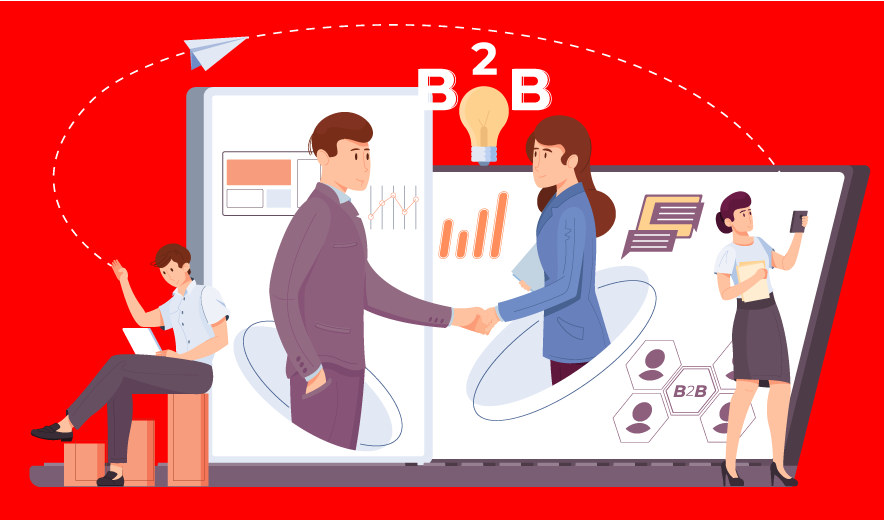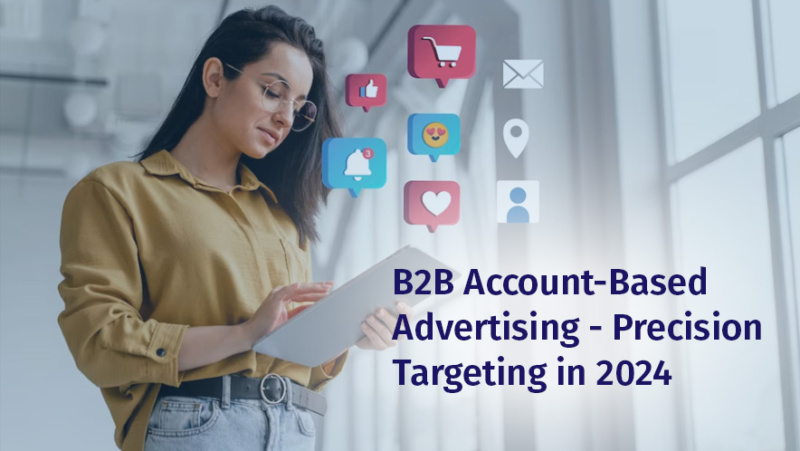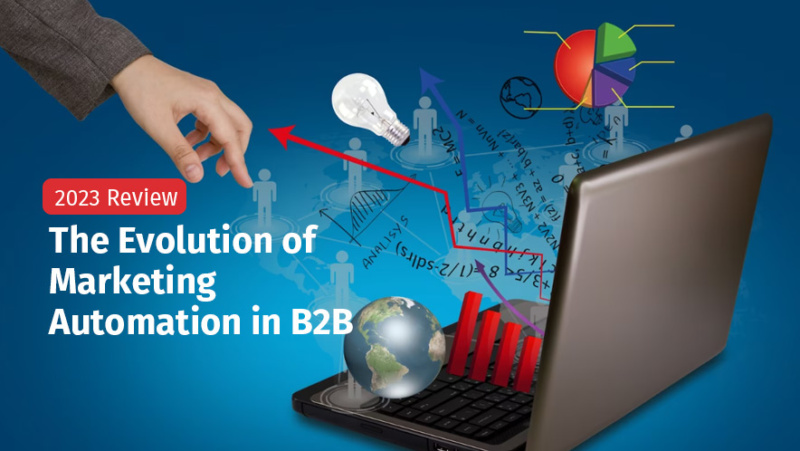Personalization is crucial in B2B marketing. It helps tailor communication to meet the unique needs of individual businesses. This goes beyond a generic approach, allowing marketers to craft messages that resonate with their target customers’ specific challenges and goals. Personalization delivers a more relevant and compelling experience to clients, enhancing the overall customer journey.
So, How Does Personalization Work in B2B Marketing?
Personalized Messages: Customizing content and interactions helps businesses improve the customer experience, showing a strong understanding of their clients’ needs. This personalized approach builds trust and loyalty, creating a positive link between the brand and its customers. Personalization not only enhances engagement but also increases the likelihood of decision-makers paying attention to marketing materials. This increased engagement can result in higher conversion rates, positively affecting the bottom line.
Data-driven Personalization: Data plays a crucial role in the personalization process, enabling B2B marketers to make informed decisions based on customer behaviors and preferences. This data-driven approach allows for more effective targeting, ensuring that resources are allocated where they are most likely to yield positive results. Moreover, personalization is instrumental in the lead nurturing process. It guides potential clients through the buyer’s journey with content that speaks directly to their needs at each stage.
Personalized Solutions: In a competitive B2B landscape, personalization serves as a key differentiator. Businesses that can effectively tailor their marketing efforts stand out, as Clients prefer businesses that understand their challenges and offer personalized solutions. Beyond acquiring new clients, personalization contributes to long-term relationship building. Consistently delivering personalized and relevant content strengthens connections, leading to repeat business, upsells, and positive referrals.
Personalization Flexibility: Personalization also offers adaptability and flexibility in the dynamic B2B markets, where different businesses may have distinct requirements. This ability to tailor approaches to diverse needs ensures that marketers can effectively meet the varied demands of their target audience. In essence, personalization isn’t just a trend in B2B marketing; it’s a strategic necessity. It builds meaningful connections, drives engagement, and contributes to long-term business success.
Advanced Personalization Techniques
Advanced personalization techniques in marketing leverage data-driven insights to create more sophisticated and tailored experiences for users. Two prominent methods in this realm are dynamic content and behavior-based personalization.
Dynamic content involves the real-time customization of website or marketing content based on user attributes, preferences, or demographics. This can range from changing headlines, images, or calls to action to suit the visitor’s profile. For example, an e-commerce site might showcase different product recommendations based on users’ past purchases or browsing behavior.
Behavior-based personalization goes beyond just tailoring content; it’s about adjusting content in real-time based on how a user behaves on a website or platform. This technique involves analyzing user behavior, such as clicks, searches, or time spent on specific pages, to predict their preferences and interests. For example, an online news site might show articles it thinks you’ll like, based on what you’ve read before.
Advantages of Personalization Beyond First Names
These advanced personalization techniques significantly boost engagement and conversion rates in several ways
Enhanced Relevance
By dynamically tailoring content based on user data and behavior, marketers can ensure that the information presented is highly relevant to the individual. This heightened relevance captures the user’s attention, increasing the likelihood of prolonged engagement.
Improved User Experience
Dynamic content and behavior-based personalization contribute to an improved user experience. Visitors feel that the platform understands their needs and preferences, creating a seamless and personalized journey. This positive experience can lead to increased satisfaction and loyalty.
Increased Interaction
Tailoring content in real-time based on user behavior encourages increased interaction. Users engage more with content that matches their interests. This includes clicking on personalized product suggestions, checking out related articles, or responding to targeted offers.
Higher Conversion Rates
Personalization directly impacts conversion rates. When users encounter content or product recommendations tailored to their preferences, they are more likely to convert. Whether making a purchase, filling out a form, or subscribing to a service, the personalized experience nudges users toward the desired conversion actions.
Precise Targeting
These techniques enable marketers to precisely target their audience based on specific behaviors or characteristics. This targeted approach ensures that resources are allocated efficiently, reaching the segments most likely to convert, and minimizing wasted efforts on less relevant audiences.
Adaptive Campaigns
Behavior-based personalization allows for adaptive marketing campaigns. As user behavior changes, the content adjusts to reflect those changes. This flexibility ensures that marketing stays in sync with user preferences, keeping a high level of engagement over time.
Enhanced personalization techniques, such as dynamic content and behavior-based personalization, change how businesses connect with their audience. They provide personalized and adaptable content based on user behavior, making the user experience more engaging and relevant. This results in increased engagement and conversion rates.
Using AI for Personalization
Artificial Intelligence (AI) is vital for making things more personalized. It uses smart algorithms and machine learning to study lots of data and provide customized experiences. AI helps businesses know what users like, guess their actions, and automatically give them personalized content. Let’s look at how AI does this, with some real examples of where it’s worked well.
Role of AI in Enhancing Personalization
Data Processing and Analysis
AI excels at processing and analyzing massive datasets. By employing machine learning algorithms, AI can identify patterns and trends within user data, enabling businesses to gain deep insights into customer preferences, behaviors, and interests.
Predictive Analytics
AI enables predictive analytics, allowing businesses to anticipate user needs and behaviors. By analyzing historical data, AI algorithms can predict what products or content a user might like, making it easier to personalize things for them.
Dynamic Content Generation
AI makes personalized content in real-time for each user. It’s more than just static personalization – it customizes experiences based on how users interact, what they like, and how they behave.
Automation and Scalability
AI personalization automates tailoring content and suggestions, even for large user bases. This guarantees businesses can efficiently provide personalized experiences without manual effort.
Adaptive Learning
AI systems are capable of adaptive learning, meaning they continuously refine their understanding of user preferences over time. As users interact with the platform, the AI algorithms learn from these interactions, enhancing the accuracy and relevance of personalization.
AI-driven personalization changes how businesses connect with their audience. It helps understand individual preferences better and automates delivering personalized content. Companies like Netflix, Amazon, Spotify, Google, and Pandora have succeeded by using AI in personalization. This leads to more satisfied users, increased engagement, and business success.
Measuring Personalization Impact
Measuring the impact of personalization in B2B marketing is crucial to understanding its effectiveness and optimizing strategies for better results.
Here are key metrics and industry benchmarks that businesses can use to evaluate the success of their personalized marketing campaigns
Conversion Rates: Track the conversion rates of personalized content or campaigns. This metric shows how well your personalized approach connects with your audience and encourages them to take specific actions, like filling out a form, downloading content, or making a purchase.
Engagement Rates: Measure the level of engagement your personalized content receives. This includes metrics like click-through rates, time spent on pages, and interactions with personalized elements. High engagement rates suggest that your content is relevant and captivating to your target audience.
Lead Generation and Nurturing: Evaluate the impact of personalization on lead generation and nurturing. Track metrics such as the number of leads generated, the quality of leads, and the progression of leads through the sales funnel. Personalized content should contribute to more effective lead nurturing and increased conversion of leads into customers.
Customer Retention: Assess the impact of personalization on customer retention. Measure customer satisfaction, repeat business, and the likelihood of customers engaging with personalized content over time. Personalization should contribute to building long-term relationships with existing customers.
ROI (Return on Investment): Calculate the return on investment for your personalized marketing efforts. Compare the costs of using personalization strategies with the revenue or value gained from those personalized campaigns. A positive ROI indicates the effectiveness of your personalization initiatives.
Segmentation Performance: Analyze the performance of different audience segments. Evaluate how well your personalization strategies resonate with specific segments, and identify any patterns or trends that can inform future targeting and personalization efforts.
Content Effectiveness: Evaluate the effectiveness of personalized content by analyzing metrics specific to each piece of content. This could include metrics like download rates, social shares, or engagement with personalized product recommendations.
Measuring the impact of personalization in B2B marketing involves assessing a combination of conversion rates, engagement metrics, lead generation, customer retention, and ROI. While industry benchmarks can provide a general guideline, businesses need to establish their baseline metrics and continuously optimize their personalization strategies based on real-time performance data.
Personalization stands as a cornerstone in B2B marketing, offering a strategic imperative beyond merely addressing clients by their first names. The ability to tailor communications to individual businesses’ unique challenges and goals creates a more compelling customer journey. The power of personalization is evident in its capacity to foster trust, loyalty, and increased engagement, ultimately impacting conversion rates positively.
Furthermore, the integration of Artificial Intelligence (AI) amplifies the impact of personalization. AI’s capabilities in data processing, predictive analytics, dynamic content generation, automation, and adaptive learning enhance the depth and efficiency of personalized experiences.
Next Steps
Want to learn more about how personalization can improve the outcome of your marketing campaigns? How to leverage AI to amplify the impact of personalization? Learn from the leaders and experts at our MarTech Pulse community.
Be a part of our community for free and access the best resources, trends, and new technologies from peers and industry experts. You can also check out our other awesome blogs over here.





